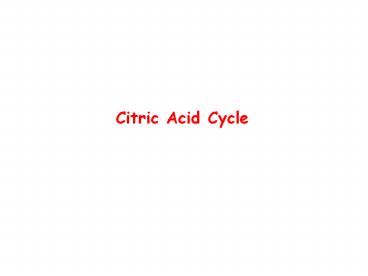Citric Acid Cycle - PowerPoint PPT Presentation
Title: Citric Acid Cycle
1
- Citric Acid Cycle
2
Gylcolysis
Electron Transport and Oxidative phosphorylation
TCA Cycle
3
The TCA Cycle
- (aka Citric Acid Cycle, Krebs Cycle)
- Pyruvate (actually acetate) from glycolysis is
degraded to CO2 - Some ATP is produced
- More NADH is made
- NADH goes on to make more ATP in electron
transport and oxidative phosphorylation
4
(No Transcript)
5
Entry into the TCA Cycle
- Pyruvate is translocated from the cytosol to the
mitochondria - Pyruvate is oxidatively decarboxylated to form
acetyl-CoA - Pyruvate dehydrogenase uses TPP, CoASH, lipoic
acid, FAD and NAD - Acetyl-CoA then enters TCA cycle thru citrate
synthase
6
Pyruvate Dehydrogenase Complex
- Composed of three enzymes
- pyruvate dehydrogenase (E1) (cofactor TPP)
- Dihydrolipoamide acetyltransferase (E2) (cofactor
Lipoamide, CoA) - Dihydrolipoamide dehydrogenase (E3) (cofactor
FAD, NAD)
7
Pyruvate Dehydrogenase
8
(No Transcript)
9
Citrate Synthase
- Only step in TCA cycle that involves the
formation of a C-C bond
10
(No Transcript)
11
Aconitase
- Isomerization of Citrate to Isocitrate
- Citrate is a poor substrate for oxidation
- So aconitase isomerizes citrate to yield
isocitrate which has a secondary -OH, which can
be oxidized - Aconitase uses an iron-sulfur cluster to position
citrate (binds OH and carboxyl of central carbon)
12
(No Transcript)
13
Isocitrate Dehydrogenase
- Oxidative decarboxylation of isocitrate to yield
? -ketoglutarate - Classic NAD chemistry (hydride removal) followed
by a decarboxylation - Isocitrate dehydrogenase is a link to the
electron transport pathway because it makes NADH - Rxn is metabolically irreversible
14
(No Transcript)
15
? -Ketoglutarate Dehydrogenase
- A second oxidative decarboxylation
- This enzyme is nearly identical to pyruvate
dehydrogenase - structurally and mechanistically - Five coenzymes used - TPP, CoASH, Lipoic acid,
NAD, FAD
16
(No Transcript)
17
Succinyl-CoA Synthetase
- A substrate-level phosphorylation
- A nucleoside triphosphate is made (ATP in
plants/bacteria and GTP in animals) - Its synthesis is driven by hydrolysis of a CoA
ester
18
(No Transcript)
19
Succinate Dehydrogenase
- An oxidation involving FAD
- Mechanism involves hydride removal by FAD and a
deprotonation - This enzyme is actually part of the electron
transport pathway in the inner mitochondrial
membrane - The electrons transferred from succinate to FAD
(to form FADH2) are passed directly to ubiquinone
(UQ) in the electron transport pathway - Enzyme inhibited by malonate
20
(No Transcript)
21
Fumarase
- Hydration across the double bond
- trans-addition of the elements of water across
the double bond - Stereospecific reaction
22
(No Transcript)
23
Malate Dehydrogenase
- An NAD-dependent oxidation
- The carbon that gets oxidized is the one that
received the -OH in the previous reaction - This reaction is energetically expensive
- ?Go' 30 kJ/mol
24
(No Transcript)
25
Reduced Coenzymes Fuel ATP Production
- Acetyl-CoA 3 NAD Q GDP Pi 2 H20 ?
HS-CoA 3NADH QH2 GTP 2 CO2 2 H - Isocitrate Dehydrogenase 1 NADH2.5 ATP
- a-ketoglutarate dehydrogenase 1 NADH2.5 ATP
- Succinyl-CoA synthetase 1 GTP1 ATP
- Sunccinate dehydrogenase 1 QH21.5 ATP
- Malate Dehydrogenase 1 NADH2.5 ATP
- Total of 10 ATPs gained from oxidation of 1
Acetyl-CoA
26
(No Transcript)
27
Regulation of TCA Cycle
28
(No Transcript)
29
TCA Cycle provides intermediates for many
biosynthetic processes
30
The Anaplerotic Reactions
- The "filling up" reactions
- PEP carboxylase - converts PEP to oxaloacetate
- Pyruvate carboxylase - converts pyruvate to
oxaloacetate - Malic enzyme converts pyruvate into malate































